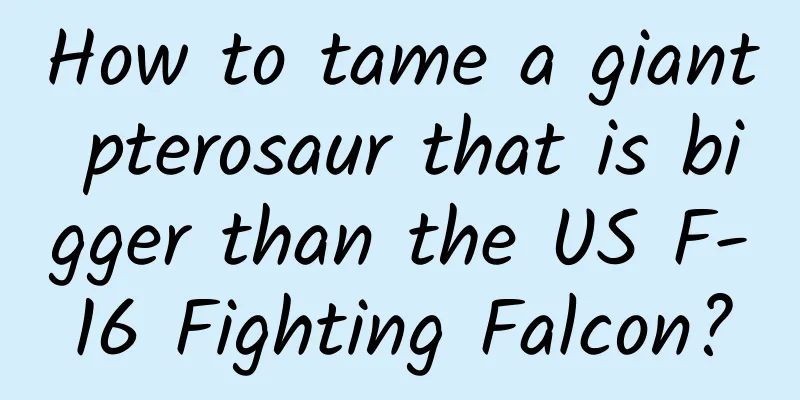How to tame a giant pterosaur that is bigger than the US F-16 Fighting Falcon?

|
Pterosaurs are probably the closest to dragons (dragons in Western mythology) among the real creatures on Earth. Except for not being able to breathe fire, pterosaurs have evolved into huge bodies with wingspans as big as airplanes. If they hadn't survived the asteroid impact at the end of the Cretaceous period, "Romance of the Three Kingdoms" might have become a "real version" of "Game of Thrones" - Guan Yu rides a dragon to kill Hua Xiong! And you might also ride a dragon to work now... But we still have hope, maybe one day a time machine will be invented. So let's learn how to raise a giant pterosaur! Written by Yang Zixiao (University College Cork, Ireland) Stills from A Song of Ice and Fire Pterosaurs are magical creatures. They are like magical animals from the world of Harry Potter, with fascinating super powers. It is hard to imagine that pterosaurs really lived on our earth. They were the first vertebrates in history to conquer the blue sky, about 100 million years earlier than the birds we are familiar with, and about 150 million years earlier than bats. And, although the skies have been taken over by their flying descendants, the world record set by pterosaurs remains to this day: they are the largest flying animals on Earth. The largest known pterosaur, Quetzalcoatlus, could reach more than ten meters when its wings were fully extended, and would be as tall as a giraffe when standing on the ground (see Figure 1, for proportional comparison). Figure 1. The giant Quetzalcoatlus is compared to a human, a giraffe, and an F-16 fighter jet (in proportion). Note that the majority of the pterosaur's wings (the fourth finger) are folded up and tucked into the sides of the body in the left picture to facilitate movement on land. (The human, pterosaur, and giraffe in the left picture were drawn by Mark Witton; the right picture was modified from the official website of the Texas Tech University Museum As the saying goes, you can’t get fat in one bite, and pterosaurs did not become so big when they first appeared. The evolution of pterosaur size can be roughly divided into two stages: the early pterosaurs (non-pterodactyloid pterosaurs) that lived in the Triassic-Jurassic period were relatively small, with most pterosaurs having a wingspan of only 1-2 meters; the pterosaurs (pterodactyloid pterosaurs) that appeared later began to grow in size, and by the Late Cretaceous period, giant pterosaurs the size of airplanes appeared, dwarfing the birds that existed at the same time [1] (see figure below). Figure 2. The evolution of pterosaur wingspan; white triangles represent early pterosaurs (non-pterodactyls), circles represent different species of pterodactyls, and grey triangles represent birds. Image source: Benson et al., 2013[1] So the question is, why can these pterosaurs that appear later grow to such a large size? Childhood of a Pterosaur When pterosaurs were first discovered, people thought they would develop altricially, just like birds. People speculated that pterosaurs might also build nests and raise their babies diligently. The young pterosaurs would grow up quickly under the careful care of their parents, and would leave their parents when they were about the same size as their parents and fly into the blue sky to live independently. Indeed, pterosaurs look very much like birds in many ways, such as wings made from specialized forelimbs, hollow bones, long snouts, and sharp claws. Scientists later discovered that pterosaurs are close relatives of dinosaurs, and some dinosaurs have survived to this day and become birds. Not only that, like birds, pterosaurs also have feathers [2, 3]. This view that pterosaurs grow up like birds has been completely overturned in the past few decades. People have found that pterosaurs actually have precocial development, and their growth strategy is closer to that of reptiles. The young pterosaurs have been independent since childhood, and their parents basically don't care about them. The evidence supporting this view mainly includes the following aspects: First, the eggshell of a pterosaur is only a very thin layer of calcium hard shell (about 30 microns, or less than one-thirtieth of a millimeter), which is much thinner than a bird egg, and is only about one-tenth the thickness of a bird eggshell; some pterosaur eggs do not even have a calcium hard shell. Therefore, the eggshell of a pterosaur is more like the soft-shelled eggs of reptiles. Pterosaur eggs are so fragile that pterosaurs certainly could not lie directly on the eggs to incubate them like birds do. They should bury the eggs like reptiles and use the appropriate environment temperature and humidity to complete the incubation [4]. Figure 4. Baby lizard hatching from its shell. Source | Like most reptiles that lay eggs, pterosaur embryos and pterosaur babies already had fully developed limbs when they were born, allowing them to move freely soon after birth. Most of the bones in the wings of pterosaur babies have little cartilage and are highly ossified; of course, the most obvious thing is their large wings - even when they are still in the eggshell, the pterosaur's iconic large wings are clearly visible [5] (see Figure 5). In fact, pterosaur babies have limb proportions similar to those of adult pterosaurs, and some of the bones are even larger in babies [6, 7]. Figure 5. Two pterosaur eggs containing embryos and corresponding reconstructions. Image modified from David M. Unwin and D. Charles Deeming, 2008[4] This is completely different from birds. Most birds have very small wings when they are born, which are almost useless. As birds grow, the proportion of their wings to their bodies continues to grow, and only when they grow to almost adult size can their wings support flight. Given that baby pterosaurs already have fully developed large wings, and some of their bones are even thicker than those of adult pterosaurs, pterosaurs should have started flying at a very young age[5]. This inference has recently been confirmed - paleontologists compared the bone strength and flight ability of young and adult pterosaurs through modeling, and found that even pterosaur babies that have just hatched have very strong bones (even stronger than adults) and excellent flight ability[8]. Consistent with this conclusion that pterosaurs can fly from birth, there is also some fossil evidence that young pterosaurs hunted and fed themselves, rather than relying on their parents for food. For example, the necks and snouts of many pterosaurs became longer and longer as they grew up; most pterosaurs with teeth had more and more teeth as they grew up, and the shape of the teeth of some pterosaurs even changed as they grew up[9]. These physiological structures are closely related to obtaining food. The changes that occurred during their growth indicate that pterosaurs constantly changed their diets and hunted different prey as they grew up, just like modern crocodiles. For example, the Nile crocodile (Crocodilus niloticus) fed on insects, spiders, and frogs when it was very young; when it grew to more than 2 meters long, it mainly ate fish, and also ate some crabs and aquatic snails; when it grew to three or four meters long, the Nile crocodile would prey on some large reptiles and mammals. Figure 6. A comparison of a newborn Germanodactylus baby (top) and an adult (bottom). Image from The Princeton Field Guide to Pterosaurs by Gregory S. Paul However, some pterosaurs were very specific, insisting on chasing after the same thing to eat from childhood to adulthood. Anurognathid pterosaurs are a typical example. As the name suggests, the most obvious feature of frog-mouthed pterosaurs is their large frog-like mouths. And like frogs, they also prefer to prey on insects. For this reason, as they grow up, their heads continue to shrink relative to their bodies, their mouths become wider, and their teeth always maintain a nail-like shape, helping them to catch insects in the air[6]. So similarly, frog-mouthed pterosaurs also live independently from childhood and do not need parental care. Figure 7. A frogmouthed pterosaur hunting insects at night. Illustration by Rudolf Himawan So, did all pterosaurs grow this way? Pterosaur eggshells are very thin and cannot support a large volume, so all pterosaur eggs and pterosaur babies should be very small. Since everyone started from the same point, why did the early pterosaurs only grow to a wingspan of one or two meters, while the giant pterosaurs that appeared in the late Cretaceous period could grow to the size of a giraffe? These giant pterosaurs must have had different childhoods. Unfortunately, most of the evidence about pterosaur growth comes from relatively small pterosaurs, and how giant pterosaurs grew up has always been an unsolved mystery. Until recently... The Childhood of a Giant Pterosaur On July 19, 2023, a study published in Proceedings of the Royal Society B: Biological Sciences finally confirmed that giant pterosaurs did have different childhoods. Smaller pterosaurs were born with fully developed large wings, while the giant pterosaur Pteranodon was born with small arms and thigh bones, but then grew rapidly as it grew (see Figure 8). Figure 8. The different growth patterns of large and small pterosaurs. Image provided by the author These skeletal parts are critical because they, and the muscle tissue attached to them, are responsible for providing the power for flight and land locomotion.[9] The delayed development of these physiological structures suggests that the babies of giant pterosaurs were not as self-sufficient as the babies of smaller pterosaurs—they needed more parental care. Figure 9. The main skeletal muscle structure of the forelimbs of Pteranodon. Image from "Pterosaurs: Natural History, Evolution, Anatomy" by Mark Witton For giant pterosaurs, it is indeed a much more reasonable growth strategy for them to be nurtured by their parents than for their parents to ignore them and let their pterosaurs grow up independently. Imagine if you want your pterosaur baby to grow up big, then there are obviously two feasible options - longer growth time and faster growth rate. However, letting the pterosaurs grow independently is obviously not conducive to implementing any of the options. Without parental care, young individuals are often the first targets of predators. For pterosaurs, studies have shown that although young pterosaurs can fly, they have a high rate of flying accidents and mortality—a similar phenomenon is also common among fledging birds that have just learned to fly [10]. Given the high mortality rate of young individuals, natural selection often favors shortening the growth period as much as possible. Juvenile individuals that live independently also tend to grow more slowly. It is not difficult to imagine that if a young pterosaur had to run around every day, whether flying to find food or avoiding predators, a large part of its energy intake would be consumed in the exhaustion, and only a small part could be used to grow its body. At the same time, due to the high metabolic level of warm-blooded animals (birds and mammals), their bones and muscles can only focus on one thing between growth and function. Fast-growing bones and muscle tissues are often weak because most of the cells in them are proliferating and differentiating; in order to meet the needs of daily support for the body, movement and other functions, bones and muscle tissues need to develop to a certain degree of maturity (tissue maturity), so that the number of proliferating and differentiating cells in them will decrease, and the overall growth rate will slow down [11, 12]. Pterosaurs are believed to have a physiological level similar to that of modern warm-blooded animals [13, 14], so there should also be this trade-off between growth rate and function realization. Therefore, parental care is a more reasonable growth strategy for giant pterosaurs. Under the careful care of their parents, pterosaur babies can enjoy a longer growth time and a faster growth rate (see the picture below). Figure 10. Pteranodon taking good care of its baby. James Robins Needless to say, the topic of how pterosaurs grew up is far from over, and we will definitely discover more diverse pterosaur childhoods. After all, pterosaurs have existed on Earth for about 150 million years, much longer than any other winged vertebrate. I hope that one day we can sit in a time machine and go back to see (and ride) these real dragons... Figure 11. Pterosaur driving tutorial. Source: BBC: How to ride a pterosaur, according to science ( References [1] Benson, RB, Frigot, RA, Goswami, A., Andres, B. and Butler, RJ, 2014. Competition and constraint drove Cope's rule in the evolution of giant flying reptiles. Nat. Commun. 5, 3567. [2] Yang, ZX, Jiang, BY, McNamara, ME, Kearns, SL, Pittman, M., Kaye, TG, Orr, PJ, Xu, X. and Benton, MJ 2019 Pterosaur integumentary structures with complex feather-like branching. Nat. Ecol. Evol. 3, 24–30. [3] Cincotta A Nicolaï, M., Campos, HBN, McNamara, M., D'Alba, L., Shawkey, MD, Kischlat, EE, Yans, J., Carleer, R., Escuillié, F. and Godefroit, P. 2022 Pterosaur melanosomes support signaling functions for early feathers. Nature 604, 684–688. [4] Unwin, DM and Deeming, DC 2008. Pterosaur eggshell structure and its implications for pterosaur reproductive biology. Zitteliana 28, 199–207. [5] Unwin, DM and Deeming, DC 2019. Prenatal development in pterosaurs and its implications for their postnatal locomotory ability. Proc. R. Soc. B: Biol. Sci. 286, 20190409. [6] Yang, Z., Benton, MJ, Hone, DW, Xu, X., McNamara, ME and Jiang, BY, 2021. Allometric analysis sheds light on the systematics and ontogeny of anurognathid pterosaurs. J. Vertebr. Paleontol. 41, e2028796. [7] Yang, Z., Jiang, BY, Benton, MJ, Xu, X., McNamara, ME and Hone, DW 2023. Allometric wing growth links parental care to pterosaur giantism. Proc. R. Soc. B: Biol. Sci. 290, 20231102. [8] Naish, D., Witton, MP and Martin-Silverstone, E. 2021. Powered flight in hatchling pterosaurs: evidence from wing form and bone strength. Sci. Rep. 11, 13130. [9] Witton, MP, 2013. Pterosaurs: natural history, evolution, anatomy. Princeton University Press. [10] Hone, DW and Henderson, DM 2014. The posture of floating pterosaurs: ecological implications for inhabiting marine and freshwater habitats. Palaeogeogr. Palaeoclimatol. Palaeoecol. 394, 89–98. [11] Ricklefs, RE, Shea, RE and Choi, IH 1994. Inverse relationship between functional maturity and exponential growth rate of avian skeletal muscle: a constraint on evolutionary response. Evolution 48,1080–1088. [12] Carrier, DR, 1996. Ontogenetic limits on locomotor performance. Physiol. Zool. 69, 467-488. [13] Wiemann, J., Menéndez, I., Crawford, JM, Fabbri, M., Gauthier, JA, Hull, PM, Norell, MA and Briggs, DE 2022. Fossil biomolecules reveal an avian metabolism in the ancestral dinosaur. Nature 606, 522–526. [14] Benton, MJ, Dhouailly, D., Jiang, B. and McNamara, M. 2019. The early origin of feathers. Trends Ecol. Evol. 34, 856–869. This article is supported by the Science Popularization China Starry Sky Project Produced by: China Association for Science and Technology Department of Science Popularization Producer: China Science and Technology Press Co., Ltd., Beijing Zhongke Xinghe Culture Media Co., Ltd. 1. Go to the "Featured Column" at the bottom of the menu of the "Fanpu" WeChat public account to read a series of popular science articles on different topics. 2. Fanpu provides a function to search articles by month. Follow the official account and reply with the four-digit year + month, such as "1903", to get the article index for March 2019, and so on. Copyright statement: Personal forwarding is welcome. Any form of media or organization is not allowed to reprint or excerpt without authorization. For reprint authorization, please contact the backstage of the "Fanpu" WeChat public account. |
<<: If you wake up like this every day, your body will be ruined!
Recommend
Double Eleven advertising farce: a bite and a bite back
As Double Eleven approaches, major e-commerce com...
The Winter Olympics menu is out! These common ingredients contain stimulants, so don't eat them!
Expert of this article: Chu Yuhao, PhD of Beijing...
Born for smart home, ZIVOO smart box offers a comprehensive experience
The original intention of the TV box was to make ...
New scientific discovery! The existence of life outside the Earth has been confirmed for the first time
8th #The first confirmed existence of life outsid...
Why is there always a colored oil layer on the glasses? Can an ultrasonic cleaner clean it?
Many people have had this experience: wearing gla...
What is it like to "catch dolls" on the moon and "speed cars" on Mars? They can tell you the answer
What is it like to "catch dolls" 380,00...
Apple iOS 15/iPadOS 15 developer preview/public beta Beta 7 released
On August 26, Apple pushed the iOS 15/iPadOS 15 d...
Understanding Private Domain Traffic in One Article (with Case Model)
In the past two years, private domain traffic has...
"Operational methods in the post-product era" How to do content operation well?
Let’s first define content operations : Everythin...
Sina Fuyi Mobile Game Industry Launch Strategy
The mobile game market seems to be booming, but m...
Samsung expected to recover with new Galaxy phones
April 3 news, according to foreign media reports,...
Teach you how to write a perfect product promotion plan in 6 steps! (2)
We will teach you how to write a perfect product ...
There are so many fried chickens, why no fried duck?
Audit expert: Wang Guoyi Postdoctoral fellow in N...
What should you do to plan an event that will go viral on WeChat Moments?
How to create an event that will go viral on WeCh...
Google testing Android/Chrome OS hybrid system 'Andromeda'
[[172434]] According to foreign media reports, Go...









